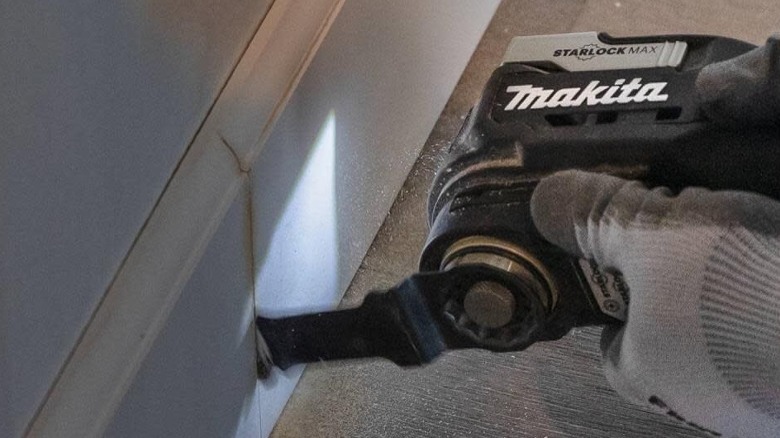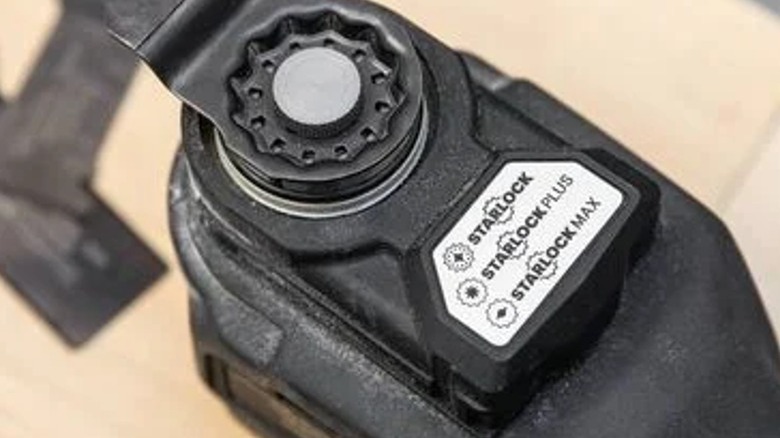Milwaukee M18 Fuel Vs. Makita Starlock Oscillating Multi-Tool: What's The Difference?
There are few cutting implements with as much utility as a good oscillating multi-tool. It probably isn't going to be the first power tool you add to your arsenal–it might not even be the tenth–but you'll be surprised how often it comes in handy once you have one. By oscillating a saw in a side-to-side motion, these tools offer an easy handheld method of performing clean, linear plunge cuts that circular and reciprocating blades can't hope to match. It can cut metal, PVC, wood, grout, or drywall. It can also sand, buff, and scrape everything from carpet adhesive to paint and rust.
Milwaukee and Makita are both counted among the best power tool brands on the market. They both offer large catalogs of cordless tools that are powered by proprietary lithium-ion battery systems. In terms of oscillating multi-tools, Milwaukee has the M18 Fuel and Makita offers the 18V LXT StarlockMax. Both of these tools come highly rated, but you might be wondering what the actual difference is between them and if one is better than the other. To get a feel for what each of these tools has to offer, it's best to compare performance specifications, features, professional reviews, and price. That way, you can be sure you're getting a tool suited to your needs.
Performance specifications are very similar
One of the first things you're going to want to look at is the raw performance on offer from each of these multi-tools. Both of them are powered by trusted 18V systems that offer batteries in a variety of ampere-hour sizes.
Milwaukee makes some bold claims in this arena–and some of them are well-earned. The M18 Tools system is powered by one of the better cordless battery options on the market, with many of its associated products making frequent appearances on best-rated power tool lists. Fuel has a Powerstate brushless motor, which Milwaukee claims "provides 10,000 RPM to deliver the fastest cutting multi-tool compared to competition to increase productivity." It states that this allows the tool to deliver 10,000-20,000 OPM (oscillations per minute.) Makita seems to match Milwaukee in performance, however. The StarlockMax is also powered by a reputable battery system and cuts at the same rate of 10,000-20,000 OPM.
The primary difference between the two seems to be the oscillation angle. This is the distance that the cutting implement travels as it arcs from side to side. The Milwaukee cuts at 4.2-degrees while the Makita has an ever-so-slightly tighter oscillation arc at 3.6-degrees. More distance traveled means more material is removed in each oscillation. So, in short, the Milwaukee cuts faster while the Makita offers greater precision. However, the difference is so minute that most users likely won't notice much difference.
There are a few differences in their designs
Now let's move on to the special features on offer from each of these oscillating multi-tools. Power tool companies often use their R&D departments to develop proprietary technologies to enhance their tools, making this an area where even tools with similar specs might stand apart.
The Milwaukee Fuel has several impressive features fashioned into its design. It has an auto-load feature, which allows you "to start slowly when making precise cuts, and automatically ramp up to the highest speed once under load." This is a useful feature for anyone doing any fine woodworking, as the precision of cuts may matter more than speed. The M18 Fuel allows for tool-free blade changing, has a variable speed dial, an LED light, and vibration dampening technology. It also has Redlink Plus Intelligence — a proprietary electronics system that allows the tool to communicate with the battery to improve the performance of both.
The Makita also has some great features. It has sizable on/off switch with a built-in locking mechanism to reduce fatigue during longer cuts and a soft start feature that makes the tool start up more smoothly. It has several of Makita's proprietary technologies baked in as well, including STAR Protection Computer Controls and XPT Extreme Protection Technology. This tool also has AVT anti-vibration tech and an LED light.
They have different connectivity options
When buying a new tool, it's always important to consider the kinds of accessories that you'll be able to use with it. The name StarlockMax on the Makita comes from the fact that it can use specialized Starlock accessories. These are made to lock into place quickly, easily, and securely. There are three varieties: Starlock, StarlockPlus, and StarlockMax. The Makita StarlockMax Oscillating Multitool is able to use accessories with all three of these connection types.
This system of locking interfaces was created by Bosch and Fein in 2016. These specialized connections utilize a 3D connection, which offers greater contact from the accessory to the tool. This promises more security as well as a stronger transfer of power from the tool to the blade. This might seem like a strong selling point for Makita if it weren't for the fact that the Milwaukee can use standard Starlocks, too. ToolBoxBuzz stated in its review of the M18 Fuel that "the tool is compatible with OIS/One Fit style blades as well as standard Starlock blades that have that OIS interface." This means that the only accessories that the Makita can use that the Milwaukee can't are the extremely specialized StarlockPlus and StarlockMax ones.
In fact, this may be more of a detriment to the Makita as it can only use Starlocks, making it much more limited in terms of how many accessories it can use. Starlocks tend to be harder to find and more expensive than standard accessories, so those who buy the Makita will be much more limited in their selection of accessories.
ToolRev found some differences in live testing
Specs are all well and good, but to truly understand the quality of a tool, it's always good to hear what professional reviewers have to say about it. This can give some insight into its real-world performance and durability. Alex of the YouTube channel ToolRev did a side-by-side comparison of both these tools as part of their "Epic Tool Battle" series to showcase a hands-on demonstration of the differences in their performance.
He found several noticeable differences in the tools. Alex pointed out that, in spite of the tools having very similar weights, the Milwaukee is longer and thinner while the Makita is shorter and fatter. This makes the Milwaukee easier to hold in certain positions, but it makes the Makita more stable and easier to get a more precise line. He preferred the power switch location on the Makita but liked that it was easier to control the variable speed dial one-handed on the Milwaukee. Alex noted that the vibration is low in both tools, but it's much lower in the Makita, likely due to its girthier design. He claimed that the auto-load feature from Milwaukee is great when it works but that it is unreliable and often jumps to full power without ramping up.
In terms of performance tests, Alex found that both tools were equally good at sanding — though the Makita vibrated less — but that the Milwaukee blows the Makita out of the water when it comes to plunge cuts. He claimed that the Makita is both slower and stalls more frequently when applying pressure.
One of them is definitely cheaper
Both tools can be purchased on their own or as part of a kit that includes a battery. The bare tool version of the Milwaukee M18 Fuel 2836-20 has an MSRP of $229.99. Meanwhile, the 2836-21 kit, which includes a 1.5 Ah battery and charger, has an official price of $329.99. That might seem a bit expensive for a multi-tool, but it can frequently be found at extremely discounted prices from certain retailers. Amazon currently sells the stand-alone tool at $169.99 and the kit for $240.98. That's still quite pricey when you compare it to something like the DeWalt 20V Max XR, which you can get for under $100.
The Makita isn't any cheaper, though. The base StarlockMax XMT04ZB MSRP is $249.00, while the XMT04R1B kit that comes with a 2 Ah battery and charger goes for a whopping $429.00. These can be found a bit cheaper, but not much. The most affordable place we could find the tool for sale was Amazon, where the tool, on its own, was retailing for $232.53.
Even without factoring in the lower cost of standard accessories, this paints a pretty clear picture that the Milwaukee 18V Fuel is the more economical option.





